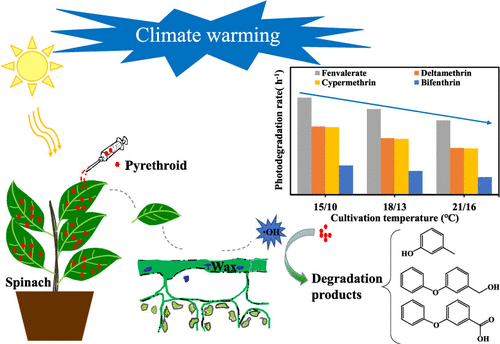当前位置:
X-MOL 学术
›
Environ. Sci. Technol.
›
论文详情
Our official English website, www.x-mol.net, welcomes your
feedback! (Note: you will need to create a separate account there.)
Elevated Temperatures Decrease the Photodegradation Rate of Pyrethroid Insecticides on Spinach Leaves: Implications for the Effect of Climate Warming
Environmental Science & Technology ( IF 10.8 ) Pub Date : 2020-12-24 , DOI: 10.1021/acs.est.0c06959 Nannan Xi 1 , Yang Li 1 , Jian Chen 1 , Yixiao Yang 2 , Jiajun Duan 1 , Xinghui Xia 1
Environmental Science & Technology ( IF 10.8 ) Pub Date : 2020-12-24 , DOI: 10.1021/acs.est.0c06959 Nannan Xi 1 , Yang Li 1 , Jian Chen 1 , Yixiao Yang 2 , Jiajun Duan 1 , Xinghui Xia 1
Affiliation

|
Climate warming is seldom considered in the transformation of pesticides on a plant leaf. This study investigated the effects of photodegradation temperature and spinach growth temperature from 15 to 21 °C on the photodegradation of bifenthrin, cypermethrin, fenvalerate, and deltamethrin on spinach leaves under xenon lamp irradiation in climate incubators. The photodegradation temperature had minor effects on pyrethroid photodegradation. Interestingly, the photodegradation rates decreased with increasing spinach growth temperature. For example, the photodegradation rate constant of bifenthrin on a spinach cultivated at 15 °C (3.73 (±0.59, 95% confidence level) × 10–2 h–1) was 1.9 times higher than that at 21 °C (1.96 (±0.17) × 10–2 h–1). Hydroxyl radicals (·OH) played a dominant role in the photodegradation. We speculate that ·OH originated from the degradation of hydroperoxide that was formed by oxidation of phenolic CH═CH, aliphatic CH3 and aromatic C–O–C, and subsequent hydrogen abstraction. The contents of these functional groups decreased with increasing growth temperature, which resulted in lower photodegradation rates at higher growth temperatures. A possible photodegradation pathway including ester bond cleavage, decyanation, and phenyl group removal was proposed. This work provides new insight into the effects of climate warming on the generation of reactive oxygen species and the transformation of pesticides on a plant leaf.
中文翻译:

升高的温度降低了菠菜叶片上拟除虫菊酯类杀虫剂的光降解速率:对气候变暖的影响
在植物叶片上的农药转化中很少考虑气候变暖。这项研究调查了在气候孵化器中氙气灯照射下菠菜叶片上联苯菊酯,氯氰菊酯,氰戊菊酯和溴氰菊酯的光降解温度和15至21°C菠菜生长温度的影响。光降解温度对拟除虫菊酯光降解影响较小。有趣的是,随着菠菜生长温度的升高,光降解速率降低。例如,联苯菊酯在15°C(3.73(±0.59,95%置信度)×10 –2 h –1)下培养的菠菜的光降解速率常数是21°C(1.96(± 0.17)×10 –2小时–1)。羟基自由基(·OH)在光降解中起主要作用。我们推测·OH源自氢过氧化物的降解,氢过氧化物的降解是酚类CHOCH,脂肪族CH 3和芳香族C– OC的氧化以及随后的氢提取所形成的。这些官能团的含量随着生长温度的升高而降低,从而导致在较高的生长温度下较低的光降解速率。提出了可能的光降解途径,包括酯键裂解,脱氰和去除苯基。这项工作为气候变暖对活性氧的产生和植物叶片上农药转化的影响提供了新的见解。
更新日期:2021-01-19
中文翻译:

升高的温度降低了菠菜叶片上拟除虫菊酯类杀虫剂的光降解速率:对气候变暖的影响
在植物叶片上的农药转化中很少考虑气候变暖。这项研究调查了在气候孵化器中氙气灯照射下菠菜叶片上联苯菊酯,氯氰菊酯,氰戊菊酯和溴氰菊酯的光降解温度和15至21°C菠菜生长温度的影响。光降解温度对拟除虫菊酯光降解影响较小。有趣的是,随着菠菜生长温度的升高,光降解速率降低。例如,联苯菊酯在15°C(3.73(±0.59,95%置信度)×10 –2 h –1)下培养的菠菜的光降解速率常数是21°C(1.96(± 0.17)×10 –2小时–1)。羟基自由基(·OH)在光降解中起主要作用。我们推测·OH源自氢过氧化物的降解,氢过氧化物的降解是酚类CHOCH,脂肪族CH 3和芳香族C– OC的氧化以及随后的氢提取所形成的。这些官能团的含量随着生长温度的升高而降低,从而导致在较高的生长温度下较低的光降解速率。提出了可能的光降解途径,包括酯键裂解,脱氰和去除苯基。这项工作为气候变暖对活性氧的产生和植物叶片上农药转化的影响提供了新的见解。











































 京公网安备 11010802027423号
京公网安备 11010802027423号